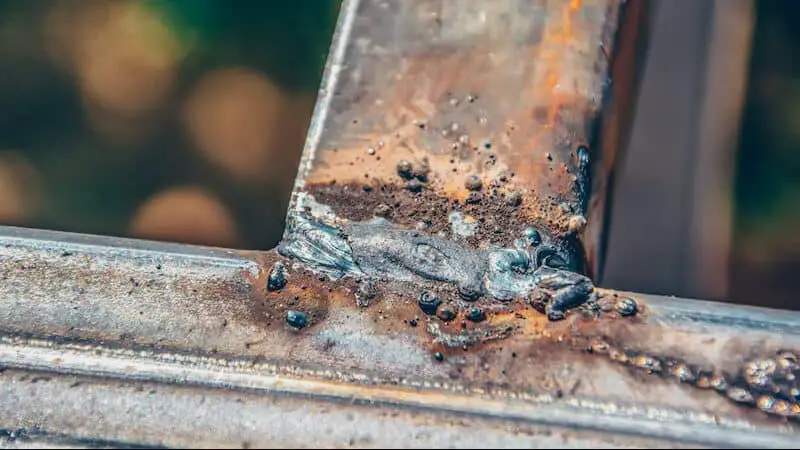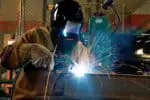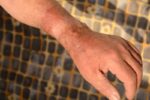The formation of what welders refer to as spatter, which is simply droplets of molten material created at or near the welding arc, is a fairly typical occurrence in gas metal arc welding.
Welding spatter refers to blobs of molten metal that are spat from your weld and fall on your work or body. The blobs are liquified and adhere to practically anything they come into contact with.
If they land on your project, you’ll have a big mess to clean up. They can burn through your overalls and injure you gravely if they land on your skin.
Spatter is triggered by a variety of factors. The primary cause is a disruption in the molten weld pool during wire transfer into the weld. Typically, this is caused by the amperage-voltage connection. This happens when the welding voltage is too low or the amperage is too high for a certain wire and gas combination.
Let us discuss this in detail.
What causes spatter in welding?
1.) Improper settings
Improper operations will result in spatter. Amperage, voltage, and electricity are all important considerations.
Amperage: In GMAW (Gas Metal Arc Welding), amperage is dictated by the wire feed speed. Spatter will occur if the amperage is too high. Reduce the amperage by slowing down the wire feed speed or raise the voltage to fix.
Voltage: As previously stated, if your voltage is too low, your spatter levels will rise. Increase the voltage until the spatter disappears.
Electric Stick Out (ESO): The space between your contact tip and the work piece is referred to as electrical stick out. When MIG welding, you should aim for a thickness of ¾ inch. A little extra for high amperage.
Excessive stick out will enhance spatter somewhat, but it will cause significant issues, that is, porosity due to lack of shielding gas and lack of penetration.
2.) Dirty Materials
Oil and other protective coatings or materials put to the metal by the manufacturer should also be considered as contamination. You can weld through most of these surface treatments, but you’ll have to clear up more spatter.
Cleanliness is also required with your filling material. It is all too easy to overlook the dirt and grease that might accumulate on welding wire or rods kept in a workplace.
Furthermore, they might corrode with time. However, unclean, rusted, or contaminated filler materials can also generate spatter.
Therefore, clean the surfaces as thoroughly as possible prior to welding.
3.) Improper welding technique
Your method may also result in excessive spatter. The angle of the MIG gun, for example, might cause spatter.
When you drift at a 15 degree angle, the quantity of spatter increases. The same is true with stick welding, and that is why your technique is important.
Allowing your arc length to grow too long increases the quantity of spatter.
There is some discussion over whether pushing or dragging during MIG welding is preferable. Regardless of the option you want, keep your drag, pull or push work angle under 15 degrees.
If reach is an issue, there are occasions when there is no other option. However, if you have control over it, do not exceed 15 degrees. Spatter is produced in large quantities at steep angles.
4.) Composition of Metal
Some metals are not meant to be welded. They have components with varying strengths that do not incorporate weldability.
Others are offered as weldable metals but are made as cheaply as possible, with inexpensive additives included into the main production process.
If you’re worried about welding spatter, avoid using either metal.
While low-cost materials are tempting, the impurities and non-weldable components included inside them frequently create considerable spatter when welded.
5.) Metal Transfer Mode
Short arc and globular transfers are metal transfer styles that generate a lot of spatter. Spray transfer is required to dramatically decrease spatter.
To do this, your shielding mix must contain at least 83 percent argon (a common mix would be 90/10). However, you must also be above the transition currents for the diameter of wire being used.
Smaller equipment will be unable to do so.
6.) Poor Shielding Gas
Although this is extremely rare, low-quality shielding gases can have an impact on spatter levels.
The smoother the arc, the greater the argon content. Although 100% carbon dioxide is inexpensive and has a high penetration profile, it produces a lot of spatter.
7.) Erratic Feeding
When the wire feeder won’t feed wire at a steady pace, there will be amperage changes that will dramatically impact the arc, resulting in a lot of spatter. Check to see if you have any feeding concerns.
How to avoid or minimize the amount of spatter while welding?
Here are a few tips you can follow to avoid spattering-
1.) You must be familiar with and comprehend the metal you are welding with. Spatter will be reduced if the material is of high quality and appropriate for welding.
This also applies to your filler. Do your homework and make sure you know what you’re getting. Get the best filler wire and rods you can locate. It is critical to the quality of your weld, and it will also aid to decrease spatter.
2.) Dirt and contamination are your worst enemies while welding, and you must clean thoroughly as part of your weld prep.
On both sides of the weld, dirt, oil, and corrosion should be removed. If required, grind, wire brush, or use a flap wheel.
Remember that your filler material must also be clean. Make sure to keep it covered and in a cool, dry spot in your business. You don’t want dirt, dust, oil, or anything else to collect on it, and you don’t want it to rust.
3.) Welding is an art in the sense that it is dependent on the user’s technique to produce a good-looking, high-quality weld. A good method is also essential for minimising weld spatter.
Therefore, do not go for complicated welding techniques if you are a novice welder.
4.) To generate high-quality welds with little spatter, your equipment must be in good condition.
The ground clamp is one of those features that is frequently ignored. The current may fluctuate as you weld if it is not clean or cannot establish adequate contact with the component. This will result in higher spatter when using a stick and a MIG welder.
And why is this spatter considered a serious problem?
Spatter may create a variety of issues in most production processes. The most prevalent ones are:
→ Spattering droplets that cling to work items or equipment
→ Damaging employees’ clothes and skin with burning, hot spatter.
→ Material loss from the arc and weld.
→ Excessive spatter cleanup which consumes a lot of time and energy.
How to clean or get rid of spatter?
Even if you take every care possible, you may find that spatter is impossible to get rid of. And when spatter arises, it is frequently necessary to clear it in order for the weld to appear its best.
However, there are three ways you can get rid of spatter-
Grinding- Grinding is one technique to clean spatter. It works, but it takes time and effort.
It won’t remove the residue like a spatter hammer, but it will grind it away to a smooth finish. If you need to conduct any final grinds on the job, it may be easier to forgo the spatter hammer and tickle the damaged surface while you’re already grinding other places, which will save you enough time.
Using a Spatter Hammer to chip- A chipping hammer is useful for removing small amounts of spatter.
These hammers are designed and produced in such a way that they swiftly remove the problematic spatter without injuring the base metal, resulting in a cleaner-looking weld.
Making use of anti-spatter sprays, gels, or tape- Another method is to avoid allowing the annoying tiny blobs to stick in the first place. You may use anti-spatter spray and gel to prevent spatter from clinging to your clothes.
You can go for the anti-spatter spray by Weld Aid Nozzle-
- Our non-flammable and paintable spray formula increases welding quality and reduces costly downtime at work
- It effectively works on tips, MIG and TIG tips, weldments, electrode holders.
- Our quick-drying technology allows for use immediately after application. Wipe away the spatter to save time and expense of scrapping and grinding
Prices pulled from the Amazon Product Advertising API on:
Product prices and availability are accurate as of the date/time indicated and are subject to change. Any price and availability information displayed on [relevant Amazon Site(s), as applicable] at the time of purchase will apply to the purchase of this product.
This handy item is an oil-based spray that you apply to your welding area. It’s designed to be welded over without hurting the quality of your weld.
It keeps the spatter from adhering to the metal, resulting in mostly loose balls on your item. The majority of them may be brushed off or readily chipped away.
It is a handy tool that you will like, but it is not without limitations. Some spatter may remain in your workpiece.
Welding Tape
This is not your typical plastic tape. It is often composed of aluminum and is put everywhere you wish to keep spatter away from, but unlike anti-spatter spray, it cannot be used directly where you weld.
It’s a pricey alternative, but it’s ideal for important elements of projects, such as a machined surface or any part that should be damaged.
It might be costly depending on where you purchase it, but it keeps all spatter from melting into the areas where you apply it.
See also: How to Remove Weld Spatter from Stainless Steel?
Conclusion
Among all of welding’s difficulties, spatter is one of the most troublesome. However, in this article, we have provided enough information to minimize the amount of spatter, and how you can get rid of them. Hope it helps!








